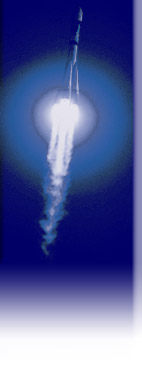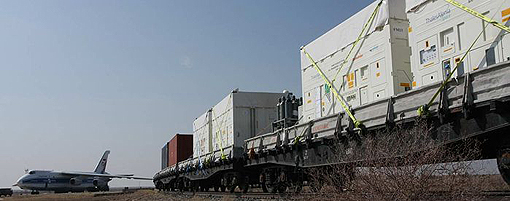

 |
 |

The second Soyuz launch campaign with Globalstar second-generation satellites has begun at Baikonur Cosmodrome
Globalstar satellites for the upcoming Soyuz mission are transported from the landing strip to Baikonur Cosmodrome’s MIK-112 facility, where they will be readied for liftoff. The satellites were delivered to Kazakhstan by an An-124 cargo jetliner.
March 22, 2011
Preparations are now underway for the next Soyuz mission to deploy Globalstar’s second-generation satellite constellation, which is scheduled during May from Kazakhstan’s Baikonur Cosmodrome.
The six spacecraft to be lofted by Soyuz arrived last week at the Cosmodrome, delivered by an Antonov An-124 that also brought the ground support equipment for the satellites’ pre-launch checkout.
Globalstar has contracted with Arianespace for a total of four Soyuz launches carrying six spacecraft each to orbit its second-generation constellation, which will be composed of 24 satellites. These flights are being performed by Starsem on behalf of Arianespace.
The mission in May will be the second such flight, building on the successful kick-off launch conducted last October. After the upcoming mission, Globalstar plans two additional flights within 60-90 days following each of the previous launches.
These spacecraft will join eight first-generation platforms launched during 2007 in support Globalstar’s current lineup of voice, Duplex and Simplex data products and services – including the company’s SPOT retail consumer products.
Globalstar’s second-generation satellites are 700-kg.-class spacecraft with a trapezoidal-shaped main body, enabling six of them to be integrated on a dispenser system for the Soyuz missions.
Soyuz launchers have played a key role in the creation of Globalstar’s satellite constellations. Eight Soyuz missions conducted by Starsem from 1999 to 2007 orbited a total of 32 first-generation Globalstar spacecraft. On these previous flights, each mission carried four of the 450-kg. first-generation satellites.
Globalstar has over 425,000 subscribers for the company’s mobile satellite voice and data services. It provides coverage in more than 120 countries around the world, with users in sectors that include oil and gas, government, business, mining, forestry, commercial fishing, utilities, military, transportation, heavy construction and emergency preparedness, along with individual recreational users.
